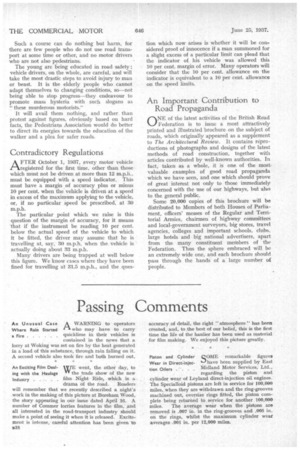Panic Pedestrian Protest
Page 31

Page 32

If you've noticed an error in this article please click here to report it so we can fix it.
DRIVERS of all classes of vehicle will doubt-. less be amazed at the action of the Pedestrians Association, which, it is reported, has prepared a memorandum protesting against the figures given on road accidents in the report of the Commissioner of Police for the Metropolis.
In his report, the Commissioner states that pedestrians are themselves to blame for 83.5 per cent. of the road accidents in which flow are injured. It is against this ,assertion that the Association bases its protest.
The action of this hysterical body of elderly pedestrians is typical of its out-of-date outlook on life. Whilk the pedestrian is entitled to the support of a representative body, this Association's policy is to protest against the development of road transport and throw the blame for all accidents upon the vehicle driver. Such a course can do nothing but harm, for there are few people who do not use road transport at some time or other, and no motor drivers who are not also pedestrians.
The young are being educated in road safety; vehicle drivers, on the whole, are careful, and will take the most drastic steps to avoid injury to man or beast. It is the elderly people who cannot adapt themselves to changing conditions, so—not being able to stop progress—they endeavour to promote mass hysteria with such slogans as "these murderous motorists."
It will avail them nothing, and rather, than protest against figures, obviously based on hard facts, the Pedestrians Assobiation would do better to direct its energies towards the education of the walker and a plea for safer roads.
Contradictory Regulations
AFTER October 1, 1937, every motor vehicle registered for the first time, other than those which must not be driven at more than 12 m.p.h., must be equipped with a speed indicator. This must have a margin of accuracy plus or minus 10 per cent. when the vehicle is driven at a speed in excess of the maximum applying to the vehicle, or, if no particular speed be prescribed, at 30 m.p.h.
The particular point which we raise is this question of the margin of accuracy, for it means that if the instrument be reading 10 per cent. below the actual speed of the vehicle to which it be fitted, the driver may assume that he is travelling at. say, 30 m.p.h. when the vehicle is actually doing about 33 m.p.h.
Many drivers are being trapped at well below this figure. We know cases where they have been fined for travelling at 31.5 m.p.h., and the ques lion which now arises is whether it will be considered proof of innocence if a man summoned for a slight excess of a particular limit can plead that the indicator of his vehicle was allowed this 10 per cent, margin of error. Many operators will consider that the 10 per cent. allowance on the indicator is equivalent to a 10 per cent. allowance on the speed limits.
An Important Contribution to Road Propaganda
QNE of the latest activities of the British Road Federation is to issue a most attractively printed and illustrated brochure on the subject of roads, which originally appeared as a supplement to The Architectural Review. It contains reproductions of photographs and designs of the latest methods of road construction, together with articles contributed by well-known authorities. In fact, taken as a whole, it is one of the mostvaluable examples of good road propaganda which we have seen, and one which should prove of great interest not only to those immediately concerned with the use of our highways, but also to the general public.
Some 20,000 copies of this brochure will be distributed to Members of both Houses of Parliament, officers' messes of the Regular and Territorial Armies, chairmen of highway committees and local-government surveyors, big stores, travel agencies, colleges and important schools, clubs, large hotels and big national advertisers, apart from the many constituent members of the Federation. Thus the sphere embraced will be an extremely wide one, and each brochure should pass through the hands of a large number of people.




























































































